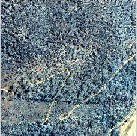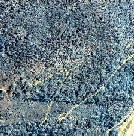International Journal of Scientific & Engineering Research, Volume 5, Issue 2, February-2014
ISSN 2229-5518
839
A Comparison of Image Fusion Methods for
IKONOS Imagery
Nidhi Gareja, Hardik M. Dhamecha
Abstract- Image fusion technique is used to integrate a high-resolution panchromatic (PAN) image and a low-resolution multispectral (MS) image to generate a multispectral image which have higher spatial resolution than original MS while preserving spectral information. There are several methods exist such as Intensity-Hue-Saturation(IHS), Generalized IHS, Brovey transform and PCA. This paper presents a comparative analysis of several image fusion methods.
Index terms- Bias, CC, Multispectral, Panchromatic, sCC, SD, VAR.
1 INTRODUCTION
HE purpose of image fusion is to combine information from multiple images of the same scene into a single image that ideally contains all the
important features from each of the original images. The resulting fused image will be thus more suitable for human and machine perception or for further image processing tasks [1]. Many image fusion schemes have been developed in the past.
2.1 IHS METHOD
A typology of simple and fast well established algorithms is known as component substitution (CS)[2]. When exactly three multispectral (MS) bands are concerned, the most straightforward CS fusion approach is to resort to an intensity–hue–saturation (IHS) transformation [3]. The Intensity component I is then substituted by the Pan image before the inverse IHS transform is applied.
RGB-IHS conversion





𝐼 1/3 1/3 1/3 𝑅
[𝑣1] = [−√2/6 −√2/6 2√2/6] [𝐺] (1)
(a) (b) (c)
𝑣2
And




1/√2 −1/√2 0 �
Fig.1 (a) PAN (b) MS (c) Fused image
𝑅 1 −1/√2 1/√2 𝐼


[𝐺] = [1 −1/√2 −1/√2] [𝑣1] (2)
Because of the trade-off between spatial and spectral
resolutions, spatial enhancement of poor-resolution

� 1 √2 0
𝑣2
multispectral (MS) data is desirable.


𝑣2
H = tan-1 ( ) and S = √𝑣1 + 𝑣2 (3)
𝑣1
Equation for IHS fusion is
2 IMAGE FUSION METHODS
𝑅′
1 −1/√2 1/√2


𝑃𝑎𝑛


[𝐺′] = [1 −1/√2 −1/√2] [ 𝑣1 ] (4)
There are several methods existed for fusing images,
some of them are described here.

�′ 1 √2 0
𝑣2
————————————————
M.E.(E.C.) student, Department of Electronics and Communication,
Where R, G, B, I, v1 and v2 represent the corresponding value for the resized original multispectral image. R’, G’, and B’ are corresponding values of the fused images. A computationally efficient method Fast IHS (FIHS) as
Marwadi Education Foundation’s Group Of Institutions, Rajkot, Gujarat,
𝑅′
𝑅 +
India. E-mail: nidhigareja@gmail.com
Asst. Prof., Department of Electronics and Communication, Marwadi Education Foundation’s Group Of Institutions, Rajkot, Gujarat, India.E- mail: hardik.dhamecha@marwadieducation.edu.in
[𝐺′] = [𝐺 + ] (5)
�′ � +

Where = Pan – I and I = 𝑅+𝐺+�
3
IJSER © 2014 http://www.ijser.org
International Journal of Scientific & Engineering Research, Volume 5, Issue 2, February-2014
ISSN 2229-5518
840
2.2 GIHS METHOD
It is a unifying image fusion method called Generalized HIS [3][5]. If more than three bands are available, a viable solution is to define a generalized IHS (GIHS) transform by including the response of the near-infrared (NIR) band into the intensity component.
3. SIMULATION RESULTS:
These Methods are applied to the IKONOS-2 data set available at [7]. An IHS method gives greater spectral distortion while preserving spatial information. This problem is somehow solved by GIHS method which includes another fourth NIR band. A problem the GIHS method is that the color of the image still changed during fusion. The color distortion problem is the
𝑅′
[ 𝐺′
�′
] = [
𝑅 + ′
𝐺 + ′
� + ′
] (6)
worst resulted by the BT and slightly better by the IHS method. This changes are clearly noticeable in fig.(2) and fig.(3) and here we compare different results using quality parameter like
𝑁𝐼𝑅′
𝑁𝐼𝑅 + ′
bias[8], SD[8], VAR[8], CC(cross-correlation)[9], spatial CC[9].
This results are shown in Table I and Table II.

Where ’=Pan – I’ and I’= 𝑅+𝐺+�+𝑁𝐼𝑅


4
2.3 BROVEY METHOD
The BT is a simple image fusion method that preserves the relative spectral contribution of each pixel but replaces its overall brightness with the high resolution PAN image [5]. It is defined as
𝑅′
𝑅 𝑅

𝑃𝑎𝑛
(a) (b)


[𝐺′] = . [𝐺] =
[𝐺] (7)
�′ � �
Where = 𝑃𝑎𝑛
𝐼
2.4 PRINCIPAL COMPONENT ANALYSIS (PCA)
METHOD
An alternative to IHS-based techniques is Principal Component Analysis (PCA) [5] [6]. Analogously to the IHS scheme, the Pan image is substituted to the first principal component (PC1). Histogram-matching of Pan to PC1 is mandatory before substitution, because the mean and variance of PC1 are generally far greater than those of Pan.

(c) (d)
𝑃�1


∅11 ∅12 ∅13 𝑅
[𝑃�2] = [∅21 ∅22 ∅23] [𝐺] (8)
𝑃�3
∅31 ∅32 ∅33 �
H = tan-1(


𝑃�3
) and S = √𝑃�2 + 𝑃�1 (9)
𝑃�2
The first component PC1 of PCA space is replaced by Pan image and retransformed back into original RGB space.
(e) (f)
Fig.2 Fusion result of IKONOS-2 images (a)MS (c)FIHS (d)GIHS
𝑅′
∅11 ∅12 ∅13
𝑃𝑎𝑛
[𝐺′] = [∅21 ∅22 ∅23] [𝑃�2] (10)
(e)Brovey (f)PCA
�′ ∅31 ∅32 ∅33
𝑃�3
IJSER © 2014 http://www.ijser.org
International Journal of Scientific & Engineering Research, Volume 5, Issue 2, February-2014
ISSN 2229-5518
841


Table I: Quality indices of IKONOS-2 image fusion result (for
images shown in fig.2)
(a) (b)


(c) (d)


(e) (f)
Fig.3 Fusion result of IKONOS-2 Vegetation area (a) MS (b) PAN (c) FIHS (d) GIHS (e ) Brovey (f) PCA
Table II: Quality indices of IKONOS-2 image fusion result (for images shown in fig.3)
| Band | FIHS | GIHS | Brovey | PCA |
BIAS | R | 0.4527 | 0.5306 | 0.4527 | 0.7122 |
BIAS | G | 0.4514 | 0.4140 | 0.4514 | 0.5307 |
BIAS | B | 0.4499 | 0.2830 | 0.4499 | 0.5699 |
SD | R | 0.2573 | 0.2830 | 0.2573 | 0.3263 |
SD | G | 0.2747 | 0.2456 | 0.2747 | 0.2546 |
SD | B | 0.2480 | 0.2264 | 0.2480 | 0.2611 |
VAR | R | 2.4773 | 2.6311 | 2.4773 | 3.5000 |
VAR | G | 5.0558 | 4.0845 | 5.0558 | 4.0247 |
VAR | B | 14.9324 | 13.2342 | 14.9324 | 17.4757 |
CC | R | 0.7629 | 0.6971 | 0.7629 | 0.6776 |
CC | G | 0.5838 | 0.6311 | 0.5838 | 0.4802 |
CC | B | 0.3313 | 0.4409 | 0.3313 | 0.4235 |
sCC | R | 0.9934 | 0.9971 | 0.9934 | 0.9988 |
sCC | G | 0.9994 | 0.9993 | 0.9994 | 0.9979 |
sCC | B | 0.9979 | 0.9987 | 0.9979 | 0.9979 |
4 CONCLUSION
Although selection of fusion algorithm is problem dependent but this review results that spatial domain
IJSER © 2014 http://www.ijser.org
International Journal of Scientific & Engineering Research, Volume 5, Issue 2, February-2014
ISSN 2229-5518
842
provide high spatial resolution. But spatial domain have image blurring problem. In general case color of fused image is more distorted in FIHS than in GIHS, Brovey and PCA. But for the vegetation area images, GIHS gives better fusion results than other methods and for the urban area images, result of Brovey method is good than other methods.
5 REFERENCES
[1] Y. Zhang, “Understanding image fusion,”
Photogrammetric Engineering Remote Sensing, vol.
70, no. 6, pp. 653–660, June 2004.
[2] Jaewan Choi, Kiyun Yu, and Yongil Kim, Member, IEEE. “A New Adaptive Component-Substitution- Based Satellite Image Fusion by Using Partial Replacement “IEEE TRANSACTIONS ON GEOSCIENCE AND REMOTE SENSING, VOL. 49, NO. 1, JANUARY 2011
[3] María González-Audícana, Xavier Otazu, Octavi Fors,
and Jesús Alvarez-Mozos,” A Low Computational
Cost Method to Fuse IKONOS Images Using the Spectral Response Function of Its Sensors”IEEE TRANSACTIONS ON GEOSCIENCE AND REMOTE SENSING, VOL. 44, NO. 6, JUNE 2006
[4] Te-Ming Tu, Ping S. Huang, Chung-Ling Hung, and
Chien-Ping Chang “A Fast Intensity–Hue–Saturation Fusion Technique with Spectral Adjustment for IKONOS Imagery” IEEE GEOSCIENCE AND REMOTE SENSING LETTERS, VOL. 1, NO. 4, OCTOBER 2004
[5] Te-Ming Tu, Shun-Chi Su, Hsuen-Chyun Shyu, Ping
S. Huang “A new look at IHS-like image fusion
methods” Information fusion 2(2001)
[6] Deepak Kumar Shahu, M.P. Parsai “Different Image Fusion Technique-A Critical Review.” International Journal of Modern Engineering Research (IJMER), Sep.-Oct. 2012
[7] “Ikonos panchromatic and ms data set available: http://www.isprs.org/data/ikonos- hobart/defaule.aspx ”
[8] Myungjin Choi, Student Member, IEEE “A New
Intensity-Hue-Saturation Fusion Approach to Image
Fusion With a Tradeoff Parameter” IEEE TRANSACTIONS ON GEOSCIENCE AND REMOTE SENSING, VOL. 44, NO. 6, JUNE 2006.
[9] Miloud Chikr El-Mezouar, Nasreddine Taleb, Kidiyo Kpalma, and Joseph Ronsin “An IHS-Based Fusion for Color Distortion Reduction and Vegetation Enhancement in IKONOS Imagery” IEEE
TRANSACTIONS ON GEOSCIENCE AND REMOTE SENSING, VOL. 49, NO. 5, MAY 2011
IJSER © 2014 http://www.ijser.org













